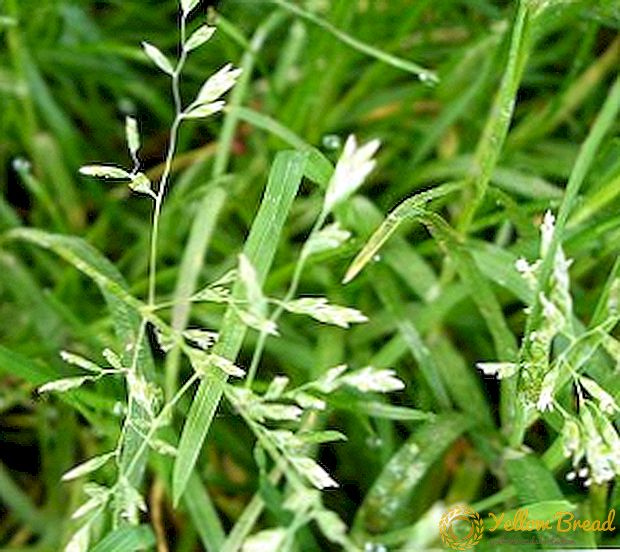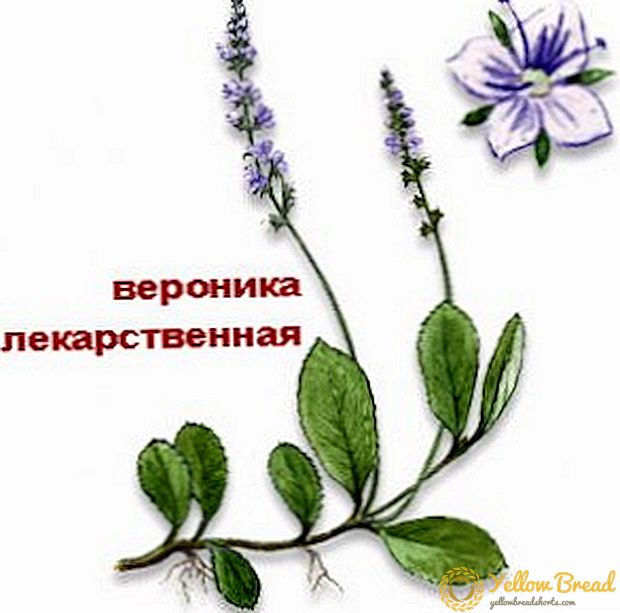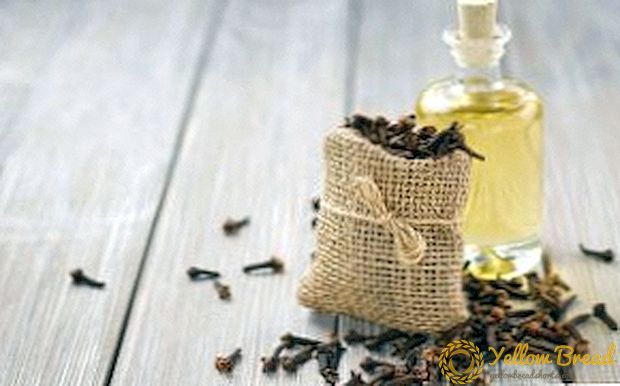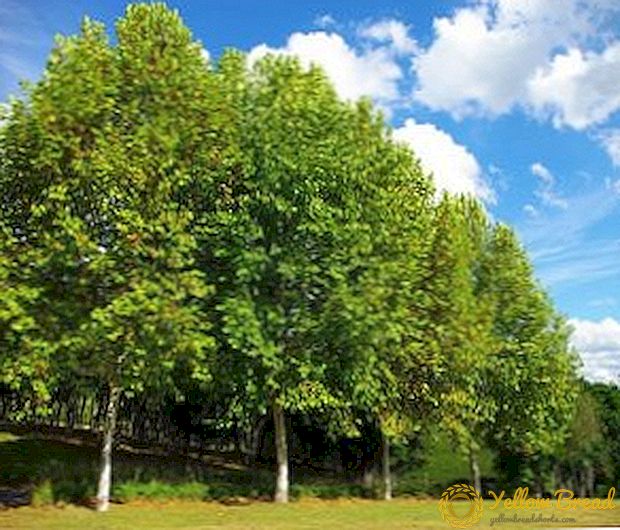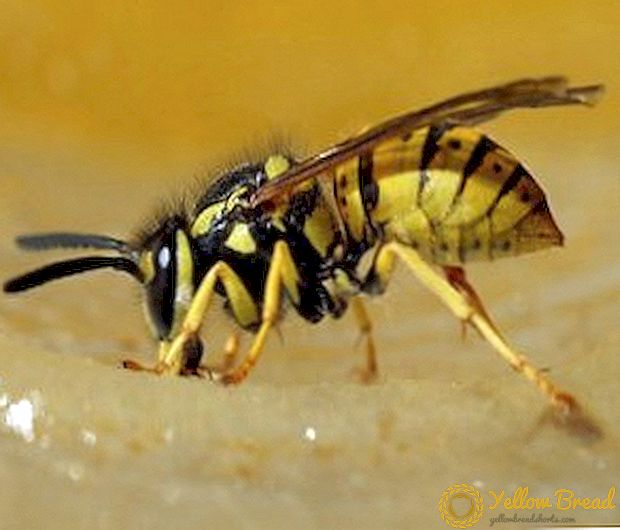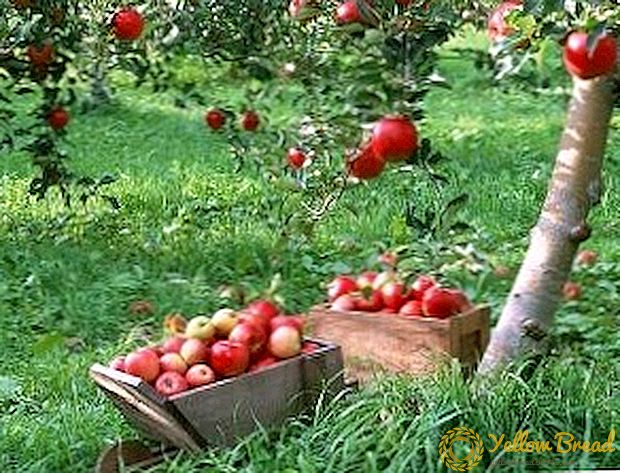
Autumn is the period on which the quality and quantity of the crop for the next year directly depends.
If you sufficiently devote your time to the care of fruit trees, then do not hesitate; in the summer you will see the result of your labors and knowledge.
Therefore, do not be lazy and put everything off for later.
It is in the autumn that it is necessary to protect the garden from diseases and pests, it is enough to fertilize, moisten and dig up the soil, and also to pay special attention to preparations for the winter.
We will talk about this in more detail.
- Whitewashing a tree
- Protection of the garden against insects
- Protection of the garden from rodents
- Pruning trees
- Feeding garden trees
- Watering garden trees
- Digging a tree
- Dead leaves
First of all, in the autumn you need to take care of the protection of fruit trees. Starting all the activities better when the foliage falls. But do not over tighten.
Terms of preparation depend on the climate of the area where the garden is planted - in the northern regions this event can be started at the end of September, and in the south - in October. Because, late preparations for winter in the north, can not only not improve the condition of the garden, but even destroy it.
Whitewashing a tree
Many people believe that whitewashing trees is a protection against harmful insects that have laid their larvae in the bark for the winter, as well as some fungal diseases. Of course, this is true, but not only. Back in 1887, it was noticed that the trees whitened with a solution of lime tolerated frosts better than their raw neighbors in the area.

Gardeners still use this experience. What is the secret? Such a coating serves as a protective layer against large temperature drops in winter, when the sun is hot during the daytime, and the frost begins to freeze at night. Untreated trees are covered with cracks, which serve as an excellent habitat for various pathogens. But here you need to know some of the nuances.
For example, when whitewashing young trees, lime in a solution can be replaced with chalk. Solution should be thick and saturated, should cover not only the trunk, but also skeletal branches. Exists several options for the preparation of the solution.
The first - the cheapest and easiest - homemade solution. For it should take 2 kg of lime + 400g of copper sulphate. These components are dissolved in 10 liters of water with the addition of paste, for viscosity.You can also add 1kg of clay and cow dung to this composition.
For young trees, the paste should not be used, their bark will not be able to breathe through the adhesive barrier. For seedlings, it is better to prepare a mixture of lime (3kg), clay (1.5kg) and mullein (1kg), which is dissolved in water to a thickness of sour cream.
Second option - This is a mixture purchased in the store, which also consists of clay and lime. However, this whitewash is often washed off by the spring, so it requires re-treatment of the entire garden. Addition of carbolic acid to any solution will also protect trees from damage by rodents and hares.
Protection of the garden against insects
The winter garden is a place for wintering various insects, which lay their larvae in the bark, fallen leaves, in the nests of the tree crown.

For example, a small nest in the form of a shield on the surface of branches is a clutch of an apple moth, which has up to 80 eggs, small beads in the form of a ring on a branch are the offspring of a silkworm, and dry leaves glued with a web to the branches can be an excellent refuge for young caterpillars of the hawthorn and goldfinder.
This is just a small list of garden pests, how can we protect it?
Firstly it is necessary to clean the entire area from excess debris and fallen leaves.Use iron brushes to remove dead bark from the trees. It is worth making a deep (15-20cm) soil digging to destroy the wintering of some caterpillars.
Carefully inspect the fruit trees, for some areas you may even need a magnifying glass. Clean the trunks of trapping belts, which are concentrated a large number of cocoon moths. Spray all plantations with 3 or 5% urea solution. Protect trees from pests such as aphid, lungwort, silkworm, leafworm helps spraying preparations "Buldok", "Fury", "Agravertini".
From diseases such as coccomycosis and other spotting will protect spraying preparations containing copper: iron sulphate, Bordeaux mixture, copper oxychloride or fungicides - Kuproksat, Topsin, Horus. The treatment with “Impact”, “Strobe” or “High” will help to get rid of scab and fruit rot. All wounds, cracks and hollows in the tree must be treated with 5% solution of ferrous sulfate and covered with cement.
Protection of the garden from rodents
Hares and small rodents cause very great damage to the garden, especially to young saplings. To protect the trees from them is necessary wrap up the trunk old rags or burlap with ruberoid. Many gardeners even use women's nylon pantyhose for this purpose. They are convenient to protect the branches.

Near the base of the protection, it is necessary to prikopat well with the ground, so that the mouse does not sneak. The branches of spruce or pine fit perfectly, they tie up the trunk and cover the near-stem circle. The smell of scattered coriander scattered on the ground near the tree, also scares off mice well.
Wrapping a garden will also save trees from winter frosts. And if you also whitewash the bark (as discussed above in the article), then your garden will not be scared and sunburn from winter rays.
You should know that if you use roofing material as a warming material, then there must be a layer of burlap or rags between it and the bark of the tree. Otherwise, the tree sopret.
Pruning trees
Pruning fruit trees should begin after the foliage is dropped. Dates vary by planting area. In the southern regions, you can leave this event for October, and in the north - you can not delay, so trimming is carried out in late September or, even better, postpone it until March.
Otherwise, the tree will not have time to prepare for the winter due to increased sap flow. When late pruning, at the site of the wound, the wood dries and freezes, which often leads to the death of the tree.

So, we proceed to the features of this procedure. Firstly remove dry and diseased branches, followed by those that create excessive thickness, grow in the direction of the trunk, at the wrong angle, intertwined with each other.
Trees that have not been pruned for many years need to be thinned in stages, over several years, starting with the largest branches and ending with small ones that do not grow correctly. If the tree is subjected to too intensive pruning, it can no longer bear fruit or even die.
Young saplings in the fall do not prune. It is necessary to thin the crown of young trees annually, it lays down their shape and proper growth. For old trees, the event is held every 2-3 years to improve the circulation of air and light between the branches, as well as to obtain a larger and better harvest.
All wounds on the tree after distant branches must be treated with garden pitch and covered with varnish or paint.All cut and trimmed twigs must be burned, because they can store spores of various diseases and pests.
Feeding garden trees
Autumn feeding plays a more important role than spring or summer. Since it is in the fall, the strength of the tree is laid before the upcoming fruiting, its immunity is strengthened and frost resistance is increased. Root top dressing is applied together with the main fertilizer during the autumn digging of the soil, in the region of the near-stem circle, no later than October.
For young trees that are less than 8 years old, about 30 kg of humus will be required, and for adults - about 50 kg. In the fall, elements such as potassium, phosphorus, nitrogen, calcium, iron and magnesium are most important.

But feeding manganese, boron, copper and cobalt, it is better to carry out in reduced quantities. The ideal option would be to ascertain which particular elements the soil lacks. But this is not always possible and convenient, so there are basic norms that should be followed.
For example, for top dressing of apple and pear trees, it is necessary with organic fertilizer to add 300 g of superphosphate and 200 g of potassium sulfate to the soil.These elements are better absorbed in liquid form by irrigating the near-barrel circle.
For cherry and plum trees, top dressing is prepared from 3 tbsp. superphosphate and 2 tbsp. potassium sulfate dissolved in 10l of water. For sufficient supply of one tree about 4 buckets of such liquid are needed. For sandy and sandy soils, more top dressing elements are required than for clay and loamy - heavier ones.
This is due to the fact that from light soils useful nutrients are more intensively washed out by precipitation and during watering. Since the beginning of fruiting, the garden needs more intensive nutrition in the autumn. Fertilizing with nitrogen is better to postpone in the spring, because in the fall this element helps to strengthen sap flow, which adversely affects the wintering of the tree.
Watering garden trees
Autumn watering allowed only in regions with low rainfall. If the tree was abundantly watered in summer and autumn, and later it was still puddled with earth, this leads to subduing, and then cracking of the bark of the trunk, in places of moisture accumulation.
Also abundant summer watering leads to increased growth of shoots, which, growing to 2m, do not have time to winter to become stiff and die from frost by the winter. Sometimes, in places where there is an excessive amount of moisture, annual grasses are sown, and weed control is stopped, which leads to the normalization of soil moisture. If the humidity of the planting region of the garden is normal, then the last watering is required no later than October.
Spuding the base of the trees with the ground is allowed only in frosty and snow-free areas, because in combination with watering this measure can damage the tree more than protect it.

Besides, the last wet autumn watering helps to strengthen the root system, eliminates the possibility of sunburn of the bark of the trunk and branches, and also provides a more successful growing season, replacing the first spring watering. Thanks to him, the root system of the tree becomes more powerful, because in winter the tree extracts moisture from a depth of 0.5-2m from the soil surface.
We were not mistaken, in winter the trees also need moisture.In drawing up the schedule of autumn irrigation should also take into account the depth of groundwater in the area. Since it is necessary to saturate the soil to a depth greater than the depth of the root system of the tree with moisture-charging irrigation.
But, is unacceptable the contact of ground and irrigation waters. The average norm for water-charging irrigation is about 10-16 buckets of water per 1 sq.m. soil.
If the soil in your garden is with shallow pebble deposits and clay layers, then the last abundant watering is required only in the years of particularly dry autumn, and usually amounts to no more than four buckets per 1 sq. M.
Digging a tree
Tillage in the fall is extremely important, and it cannot be replaced with spring, as inexperienced summer residents often think. As a result of loosening, the soil is enriched with oxygen, the larvae and eggs of various pests that die in the winter die, the roots and weed seeds are decomposed.
To complete all the activities of loosening and digging is necessary no later than the end of October. It should be remembered that in young one-year-old seedlings, digging should not be carried out to a great depth in order not to damage the roots.
And with systematic autumn loosening, there is evidence that the apple tree has the bulk of the roots on the seed stock within a radius of 20-60 cm, in the plum tree on the clone rootstock, and in the cherry tree on the horizon 20-40 cm. Around the trunk of the sea buckthorn, digging is done by carefully loosening the rake to a depth of about 7 cm, while being careful not to touch the roots.
If you have picked up a shovel, then it must be positioned with an edge towards the trunk of the fruit tree. If the garden is not subjected to systematic loosening, then the root system pulls up to the surface, which creates the risk of its damage and freezing in winter.
This can lead to the fact that the tree will be without a significant mechanism for obtaining nutrition and moisture, and the open wound surfaces of the roots will become a zone of penetration of all sorts of infections and diseases. Also consider the composition of the soil in your garden. Light, loose, cultivated soil needs only loosening, and heavy, clay - requires mandatory deep digging.
Dead leaves
Exists 2 options for how to deal with the fallen leaves in the garden. Some gardeners believe that nothing needs to be done with it, because nobody removes leaves in the wild, they rot through the natural process and serve as an excellent fertilizer in the future.

Others believe that the fallen leaves are a huge risk of infection with various diseases and pests, because it is there that the larvae and eggs of insects overwinter and disease spores can remain, so it must be cleaned and burned. Both are right.
Therefore, before deciding how to deal with the fallen leaves, you should pay attention to whether your site was infected with any diseases and pests. Even if this is so, then collecting the foliage in the bags, you will not allow it to cringe, and all the disease-causing microbes will die from frost. In the spring, this foliage should be folded in a pile for rotting.
This process can be accelerated by periodic shoveling and irrigation with microorganisms that contribute to the formation of humus. If your trees are absolutely healthy, then the collected foliage can serve as an excellent shelter from the cold of the root system of trees, and after that, a wonderful top dressing of the soil.In the presence of a large number of pests and diseases, it is better not to use the fallen leaves, but to collect them in a pile and burn them.

